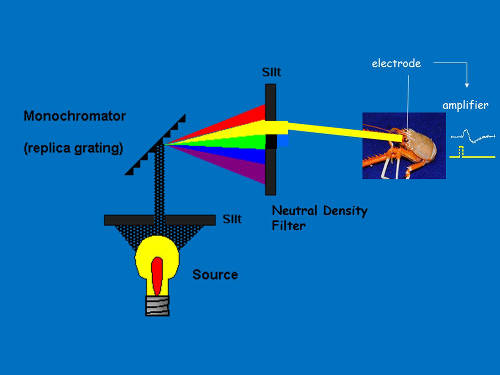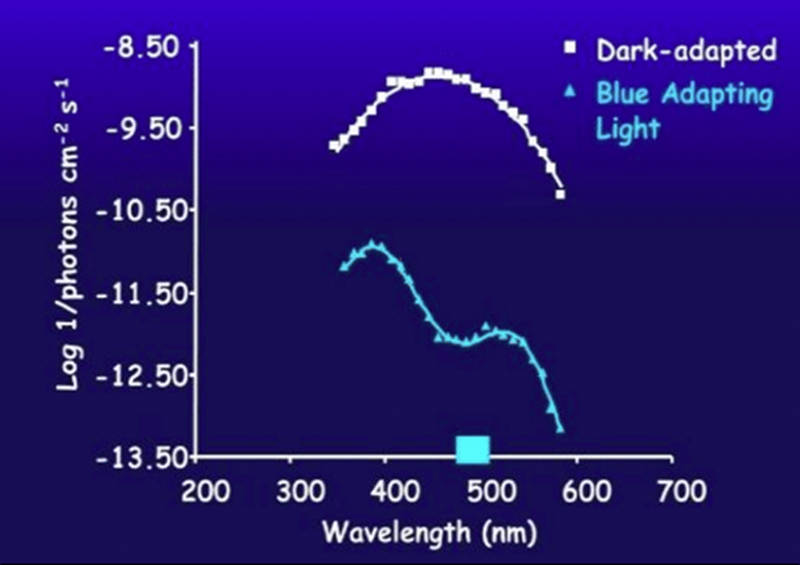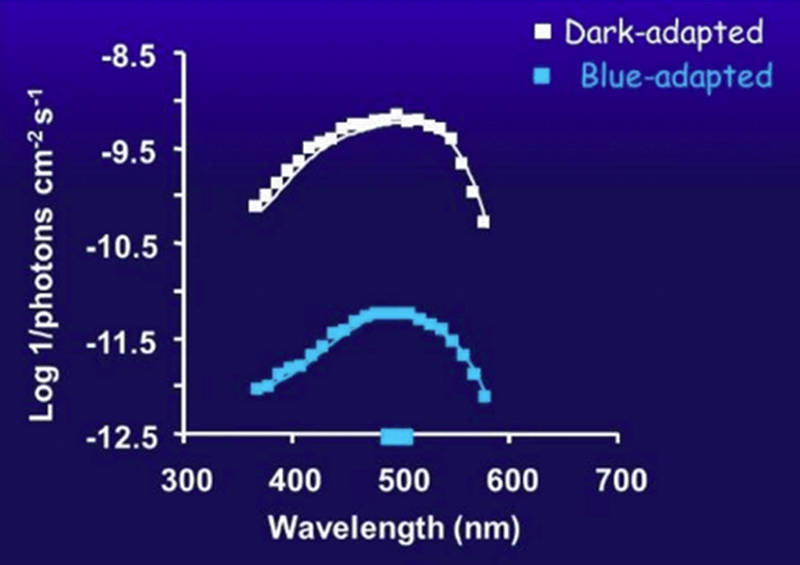
By Tamara Frank, Nova Southeastern University
Most deep-sea animals do not have color vision. They have a single, blue-sensitive, visual pigment because 1) as you go deeper through water in the ocean, all the colors disappear except for blue and 2) most bioluminescence is blue. Why waste space in your eyes for multiple visual pigments when there’s only blue light to see?
There are exceptions, of course, and that’s when things get really interesting. So far, we know that in one family of deep-sea shrimp, the Oplophoridae, several species have a near ultraviolet (UV) visual pigment in addition to the expected blue visual pigment. There is no UV light left from the sun after about 200 meters (655 feet) depth – it’s all blue light – so we think this extraordinary visual pigment system has to do with bioluminescence.
There are two forms of bioluminescence in the deep sea (see this essay by Sönke Johnsen on bioluminescence for more details) – light from photophores, which are light producing organs like a firefly has, and a bioluminescent spew, like the ink produced by a squid, except that this glows very brightly.
Some deep-sea animals have a bioluminescent spew and some have photophores; the shrimp with the UV and blue visual pigments are the only ones we know of that have both spew and photophores. “That we know of” are the important terms here, because we know so little about animals that live below 1,000 meters (3,280 feet). On this expedition, we’re hoping to learn more about both their bioluminescence and their visual adaptations. So, how do we study vision in deep-sea animals?

Figure 1. Diagram of monochromatic light stimulus. Image courtesy of Journey into Midnight: Light and Life Below the Twilight Zone. Download image (jpg, 24 KB).
These experiments can only be conducted on live crustaceans that have been collected and brought to the surface in the dark and in cold water. Since I don’t speak “crustacean”, I must get the crustacean’s eye to tell me what colors it can see. This is done by placing an electrode on the eye and recording the response from the eye when light is flashed on it (I could record the same response to light from your eye, using a contact lens electrode, if you let me).
This response is generated by a large number of receptor cells in the eye that contain visual pigment. The visual pigment absorbs light and converts it to electrical energy, which is recorded by the electrode. The more light it absorbs, the bigger the signal. Since most deep-sea species have blue sensitive visual pigments, flashing a blue light on the eye will produce a bigger signal than a yellow light of the same intensity, because the blue sensitive visual pigment absorbs more blue light than yellow light. Using a device called a monochromator (Figure 1) to split white light into individual colors, together with a neutral density filter, I can shine different colors on the eye, matched for intensity, and based on the size of the response, determine what colors the animals see best.
Now, the problem is that, in crustacean eyes, if there are two visual pigments present, approximately 85 percent of the cells contain the blue-sensitive visual pigment and only approximately 15 percent contain the other one. The contribution of the blue sensitive cells completely swamps any signal from the minority cells in the dark-adapted eye, so in order to tell if a second visual pigment is present, I must do a chromatic adaptation experiment. This means shining a dim blue light on the eye for about half an hour, converting most (not all) of the blue visual pigment into a form that no longer absorbs light. With the blue cells no longer contributing very much to the response, the electrical signal from cells containing another visual pigment now become visible.

Figure 2. Spectral sensitivity of a dark-adapted eye (white) and after chromatic adaptation with blue light (blue line) in a species with blue and violet visual pigments. Image courtesy of Journey into Midnight: Light and Life Below the Twilight Zone. Download image (jpg, 35 KB).

Figure 3. Spectral sensitivity of a dark-adapted eye (white) and after chromatic adaptation with blue light (blue line) in a species with a single blue visual pigment. Image courtesy of Journey into Midnight: Light and Life Below the Twilight Zone. Download image (jpg, 34 KB).
In Figure 2, the white curve is from the dark-adapted eye, and demonstrates peak sensitivity to blue light. After adapting the eye to blue light, the contribution of violet sensitive cells now dominates the response. In an eye with a single visual pigment (Figure 3), shining a blue light on the eye decreases the sensitivity, but there’s still just a single peak of sensitivity, just like in the dark-adapted eye.
All of these experiments will be conducted on crustaceans, because they come up in much better shape than the soft-bodied fish or squid.